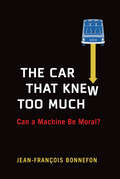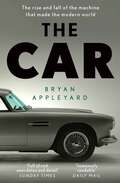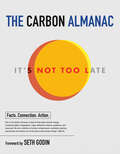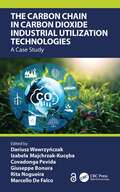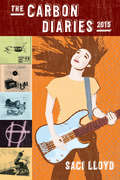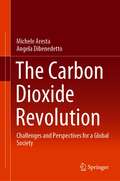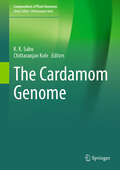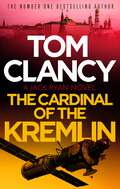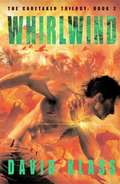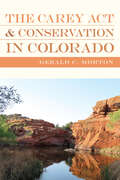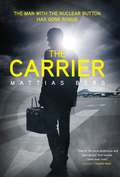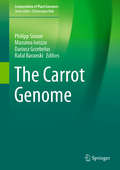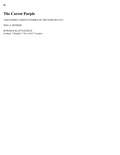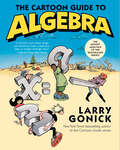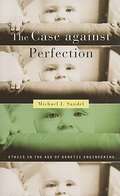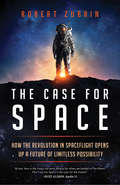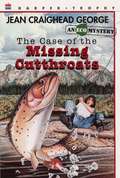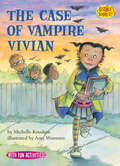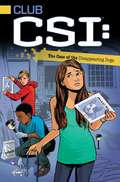- Table View
- List View
The Car That Knew Too Much: Can a Machine Be Moral?
by Jean-Francois BonnefonThe inside story of the groundbreaking experiment that captured what people think about the life-and-death dilemmas posed by driverless cars.Human drivers don't find themselves facing such moral dilemmas as "should I sacrifice myself by driving off a cliff if that could save the life of a little girl on the road?" Human brains aren't fast enough to make that kind of calculation; the car is over the cliff in a nanosecond. A self-driving car, on the other hand, can compute fast enough to make such a decision--to do whatever humans have programmed it to do. But what should that be? This book investigates how people want driverless cars to decide matters of life and death. In The Car That Knew Too Much, psychologist Jean-François Bonnefon reports on a groundbreaking experiment that captured what people think cars should do in situations where not everyone can be saved. Sacrifice the passengers for pedestrians? Save children rather than adults? Kill one person so many can live? Bonnefon and his collaborators Iyad Rahwan and Azim Shariff designed the largest experiment in moral psychology ever: the Moral Machine, an interactive website that has allowed people --eventually, millions of them, from 233 countries and territories--to make choices within detailed accident scenarios. Bonnefon discusses the responses (reporting, among other things, that babies, children, and pregnant women were most likely to be saved), the media frenzy over news of the experiment, and scholarly responses to it. Boosters for driverless cars argue that they will be in fewer accidents than human-driven cars. It's up to humans to decide how many fatal accidents we will allow these cars to have.
The Car: The rise and fall of the machine that made the modern world
by Bryan AppleyardMore than any other technology, cars have transformed our culture. Cars have created vast wealth as well as novel dreams of freedom and mobility. They have transformed our sense of distance and made the world infinitely more available to our eyes and our imaginations. They have inspired cinema, music and literature; they have, by their need for roads, bridges, filling stations, huge factories and global supply chains, re-engineered the world. Almost everything we now need, want, imagine or aspire to assumes the existence of cars in all their limitless power and their complex systems of meanings.This book celebrates the immense drama and beauty of the car, of the genius embodied in the Ford Model T, of the glory of the brilliant-red Mercedes Benz S-Class made by workers for Nelson Mandela on his release from prison, of Kanye West's 'chopped' Maybach, of the salvation of the Volkswagen Beetle by Major Ivan Hirst, of Elvis Presley's 100 Cadillacs, of the Rolls-Royce Silver Ghost and the BMC Mini and even of that harbinger of the end - the Tesla Model S and its creator Elon Musk.As the age of the car as we know it comes to an end, Bryan Appleyard's brilliantly insightful book tells the story of the rise and fall of the incredible machine that made the modern world what it is today.
The Carbon Almanac: It's Not Too Late
by The Carbon Almanac NetworkWhen it comes to the climate, we don&’t need more marketing or anxiety. We need established facts and a plan for collective action.The climate is the fundamental issue of our time, and now we face a critical decision. Whether to be optimistic or fatalistic, whether to profess skepticism or to take action. Yet it seems we can barely agree on what is really going on, let alone what needs to be done. We urgently need facts, not opinions. Insights, not statistics. And a shift from thinking about climate change as a &“me&” problem to a &“we&” problem. The Carbon Almanac is a once-in-a-lifetime collaboration between hundreds of writers, researchers, thinkers, and illustrators that focuses on what we know, what has come before, and what might happen next. Drawing on over 1,000 data points, the book uses cartoons, quotes, illustrations, tables, histories, and articles to lay out carbon&’s impact on our food system, ocean acidity, agriculture, energy, biodiversity, extreme weather events, the economy, human health, and best and worst-case scenarios. Visually engaging and built to share, The Carbon Almanac is the definitive source for facts and the basis for a global movement to fight climate change. This isn&’t what the oil companies, marketers, activists, or politicians want you to believe. This is what&’s really happening, right now. Our planet is in trouble, and no one concerned group, corporation, country, or hemisphere can address this on its own. Self-interest only increases the problem. We are in this together. And it&’s not too late for concerted, collective action for change.
The Carbon Chain in Carbon Dioxide Industrial Utilization Technologies: A Case Study
by Dariusz WawrzyńczakA shift towards implementation of renewable energy has disadvantages, such as power availability, storage capacity, and accompanying costs, and therefore the potential of clean fossil fuel technologies to ensure the stability of electricity generation needs to be reconsidered until these challenges will be overcome. These clean technologies can help prevent the greenhouse effect and, at the same time, guarantee energy security, as coal is a widespread, price-stable raw material that is available in large quantities. This book focuses on the carbon chain, starting from the formation of CO2, through its capture, possible cleaning, to the production of useful products such as dimethylether, methanol, and carbonated cement prefabricates. The comprehensive case study presents the research results of an international team established within the "CCS-CCU technology for carbon footprint reduction using bio-adsorbents" (BIOCO2) project.
The Carbon Diaries 2015
by Saci LloydIt's the year 2015, and global warming is ravaging the environment. In response, the United Kingdom mandates carbon rationing. <P><P>When her carbon debit card arrives in the mail, sixteen-year-old Laura is just trying to handle the pressure of exams, keep her straight-X punk band on track, and catch the attention of her gorgeous classmate Ravi. <P><P>But as multiple natural disasters strike and Laura's parents head toward divorce, her world spirals out of control. <P><P>With the highest-category hurricane in history heading straight toward London, chronicling the daily insanity is all Laura can do to stay grounded in a world where disaster is the norm.
The Carbon Dioxide Revolution: Challenges and Perspectives for a Global Society
by Michele Aresta Angela DibenedettoThis book focuses on carbon dioxide and its global role in our everyday life. Starting with society's dependency on energy, it demonstrates the various sources of carbon dioxide and discusses the putative effects of its accumulation in the atmosphere and its impact on the climate. It then provides an overview of how we can reduce carbon dioxide production and reviews innovative technologies and alternative energy resources. The book closes with a perspective on how carbon dioxide can be utilized reasonably and how mimicking nature can provide us with a solution. Using simple language, this book discusses one of today's biggest challenges for the future of our planet in a way that is understandable for the general public. The authors also provide deep insights into specific issues, making the book a useful resource for researchers and students.
The Carbon Footprint Handbook
by Subramanian Senthilkannan MuthuThorough and detailed, The Carbon Footprint Handbook encompasses all areas of carbon footprint, including the scientific elements, methodological and technological aspects, standards, industrial case studies, and communication of carbon footprint results. Written and edited by an international group of experts, the far-ranging topics on carbon foot
The Cardamom Genome (Compendium of Plant Genomes)
by Chittaranjan Kole K. K. SabuThis book is the first comprehensive compilation of elucidation of the genome of cardamom (Elettaria cardamomum Maton) and its genetic improvement. It includes reviews on the genetic resources, genetics and breeding and in vitro culture in cardamom and molecular characterization of phylogenetic relationship of cardamom of Columbia and Costa Rica. This book presents deliberations on the whole genome sequencing and SSR markers of small cardamom. It also enumerates on the genetics and genomics of biotic stress and host-pathogen interaction, genomics of flavors, and transcriptomics resources and their implications and finally functional regulation of mRNAs in cardamom. Altogether, the book contains about 150 pages over 10 chapters authored by globally reputed experts on the relevant field in this crop. The book is useful to the students, teachers, and scientists in the academia and relevant private companies interested in classical genetics and breeding, molecular genetics, structural genomics, functional genomics, plant pathology and plant physiology of cardamom.
The Cardinal of the Kremlin: An electrifying Jack Ryan thriller that will have your heart racing (Jack Ryan #3)
by Tom Clancy'The best of the Jack Ryan series!' New York TimesThe superpower arms negotiations appear to be making progress. But a US spy satellite reveals that the Soviets are building a massive laser-defence system controlled from an other-worldly array of pillars and domes in the Soviet hills at Dushanbe near the border of war-torn Afghanistan.The Americans need more information. The man to give it is Colonel Mikhail Filitov of the Soviet Union, codename Cardinal, America's highest-placed agent in the Kremlin. But Filitov's cover is about to be betrayed to the KGB, and CIA adviser Jack Ryan must rescue Filitov and bring him to safety . . .
The Caretaker Trilogy, Book 1: Firestorm
by David KlassThe face of death watching me. Constantly being chased and tracked, by a nameless, faceless army. Can't trust anyone . . . His mother is not his mother. His father is not his father. And if he hadn't broken the high school rushing record that night, nothing would have changed. He'd just be going out for pizza, playing football, trying yet again to score with his girl friend, P.J. But he did break the record. He appeared on the news. And now they have found him. Ripped from the only world he's ever known, Jack plunges into a space-timebending game of survival with no way out. The rules are shrouded in secrets they say he can't handle. But some things he learns fast: Trust no one. Never forget that your friends could reveal themselves as your enemies at any second. Every turn leads to a betrayal. And if you don't go along with it, you die. After centuries of abuse, the earth is dying, and it's up to Jack to reverse the decline before the Turning Point, when nothing will ever be the same again. Beaten into shape by a ninja babe and a huge, shaggy, telepathic man's best friend, Jack hurtles across the ocean to save the future from the present and to solve the mystery of his purpose. Exactly who, or what, is Firestorm, and what does it have to do with Jack? And what comes next when everything you have ever known turns out to be wrong? In the first book of the Caretaker Trilogy, David Klass has created a thrilling world where nothing is as it seems. Firestorm is an electrifying adventure of hunting truth and raging hormones, all in the name of staying alive.
The Caretaker Trilogy, Book 2: Whirlwind
by David KlassIn Firestorm, the first book of the Caretaker Trilogy, seventeen-year-old Jack Danielson saved the world's oceans, but at great personal cost-his parents were killed and everything he knew and believed was turned upside down. Now Jack has come home to see P.J., his girlfriend and sole remaining touchstone. But she's missing, and blame falls on Jack. On the run with Gisco, his crafty canine sidekick, Jack is literally caught up in a whirlwind as he travels to the heart of darkness to rescue P.J.-a journey that will bring him face-to-face with the father of his old nemesis, the Dark Lord from the future, as well as a beautiful and mysterious ally. Jack's quest becomes all the more complicated as he discovers that the only person who can stop the Dark Lord is another time traveler, one who has become lost in the present. Searching him out, Jack encounters almost unendurable horrors, learns to appreciate the savage beauty of the rain forest, and is forced to confront shocking truths about himself and the people he loves. David Klass mixes heart-racing adventure with an urgent ecological warning about the fragility of the world's rain forests and the importance of respect for indigenous peoples.
The Caretaker Trilogy, Book 3: Timelock
by David KlassJack discovers that the only way to protect the Earth from ecological disaster at the hands of the Dark Army is to lock time, and he must choose between staying in the present or returning to the future world from which he came.
The Carey Act and Conservation in Colorado
by Gerald C. MortonThe Carey Act and Conservation in Colorado is an environmental history of the endless missteps and unforeseen consequences that characterized Colorado’s participation in the Carey Act—an 1894 federal law that granted one million acres of desert-classified public land to each western state for private irrigation development and settlement. In this inclusive narrative, author Gerald Morton reveals how this obscure law affected thirty-four of Colorado’s most arid stretches of landscape. Morton contextualizes the Carey Act’s significance in Colorado through a study of the Two Buttes and Muddy Creek projects in the state’s southeastern corner—tragic examples of the disconnect among developers seeking windfall profits in the face of financial rollercoasters, the challenge of reclaiming remote sagebrush country, and settlers seeking viable livelihoods that eventually led conservationists to reimagine the failures as public wildlife refuges. A collision of values between developers and settlers lay at the center of those wildlife habitat conservation efforts, forcing people to rethink their relationship with the land and ephemeral streams—an awareness that correlated with the advent of modern ecology. The Carey Act and Conservation in Colorado is the untold story of the manipulation of nature and the reconceived use of land for public wildlife areas on the southern plains of the American West. Offering original research on arid lands policy, federal and state agency oversight, irrigation bond financing, heartbroken settlers’ grievances, individual developers’ motives, and the rise of wildlife conservation, this compelling tale of misfortune will appeal to scholars and general readers interested in conservationist and environmental history in the American West.
The Carrier
by Mattias BergThe man with the nuclear briefcase has gone rogue - Mission Impossible meets the Hunt for Red October "What should a thriller do to rise above the ranks of the clichéd? It does no harm to demonstrate some intelligence and (if possible) an engagement with serious issues - but no polemics. Thankfully, Mattias Berg's The Carrier hits those targets squarely" Barry Forshaw, Financial Times"Enjoyable, ingenious . . . packed with fascinatingly arcane nuclear facts" Myles McWeeney, Irish IndependentErasmus Levine has a job like no other He travels with the President of the United States at all times, and holds in his hands the power to obliterate life as we know it. He is the man with the nuclear briefcase, part of a crack team of top-secret operatives established after 9/11, led by a man codenamed Edelweiss. But not even Edelweiss is party to the identity of their ultimate authority, known only as Alpha.Erasmus Levine has a secretFor years he has been receiving cryptic messages from Alpha, an elaborate communication that began with the words we two against the world. Levine begins thinking of escape: his chance comes during an official visit to Sweden, when the alarm sounds in Stockholm's Grand Hotel.But Alpha has other plansFrom their first meeting in a network of tunnels and bunkers beneath the city, Levine is drawn into a plan to eliminate the world's nuclear arsenals. But is controlled demolition really the endgame? Could he be working towards a controlled apocalypse, a doomsday plot to wipe humanity from the face of the earth?Translated from the Swedish by George Goulding
The Carrier
by Mattias BergThe man with the nuclear briefcase has gone rogue - Mission Impossible meets the Hunt for Red October"What should a thriller do to rise above the ranks of the clichéd? It does no harm to demonstrate some intelligence and (if possible) an engagement with serious issues - but no polemics. Thankfully, Mattias Berg's The Carrier hits those targets squarely" Barry Forshaw, Financial Times"Enjoyable, ingenious . . . packed with fascinatingly arcane nuclear facts" Myles McWeeney, Irish IndependentErasmus Levine has a job like no otherHe travels with the President of the United States at all times, and holds in his hands the power to obliterate life as we know it. He is the man with the nuclear briefcase, part of a crack team of top-secret operatives established after 9/11, led by a man codenamed Edelweiss. But not even Edelweiss is party to the identity of their ultimate authority, known only as Alpha.Erasmus Levine has a secretFor years he has been receiving cryptic messages from Alpha, an elaborate communication that began with the words we two against the world. Levine begins thinking of escape: his chance comes during an official visit to Sweden, when the alarm sounds in Stockholm's Grand Hotel.But Alpha has other plansFrom their first meeting in a network of tunnels and bunkers beneath the city, Levine is drawn into a plan to eliminate the world's nuclear arsenals. But is controlled demolition really the endgame? Could he be working towards a controlled apocalypse, a doomsday plot to wipe humanity from the face of the earth?Translated from the Swedish by George Goulding
The Carrot Genome (Compendium of Plant Genomes)
by Philipp Simon Massimo Iorizzo Dariusz Grzebelus Rafal BaranskiThis book provides an up-to-date review and analysis of the carrot’s nuclear and organellar genome structure and evolution. In addition, it highlights applications of carrot genomic information to elucidate the carrot’s natural and agricultural history, reproductive biology, and the genetic basis of traits important in agriculture and human health. The carrot genome was sequenced in 2016, and its relatively small diploid genome, combined with the fact that it is the most complete root crop genome released to date and the first-ever Euasterid II genome to be sequenced, mean the carrot has an important role in the study of plant development and evolution. In addition, the carrot is among the top ten vegetables grown worldwide, and the abundant orange provitamin A carotenoids that account for its familiar orange color make it the richest crop source of vitamin A in the US diet, and in much of the world. This book includes the latest genetic maps, genetic tools and resources, and covers advances in genetic engineering that are relevant for plant breeders and biologists alike.
The Carrot Purple and other Curious Stories of the Food We Eat (Rowman & Littlefield Studies in Food and Gastronomy)
by Joel S. DenkerHow many otherwise well-educated readers know that the familiar orange carrot was once a novelty? It is a little more than 400 years old. Domesticated in Afghanistan in 900 AD, the purple carrot, in fact, was the dominant variety until Dutch gardeners bred the young upstart in the seventeenth century. After surveying paintings from this era in the Louvre and other museums, Dutch agronomist Otto Banga discovered this stunning transformation. <p><p>The story of the carrot is just one of the hidden tales this book recounts. Through portraits of a wide range of foods we eat and love, from artichokes to strawberries, The Carrot Purple traces the path of foods from obscurity to familiarity. Joel Denker explores how these edible plants were, in diverse settings, invested with new meaning. They acquired not only culinary significance but also ceremonial, medicinal, and economic importance. Foods were variously savored, revered, and reviled. <p><p>This entertaining history will enhance the reader’s appreciation of a wide array of foods we take for granted. From the carrot to the cabbage, from cinnamon to coffee, from the peanut to the pistachio, the plants, beans, nuts, and spices we eat have little-known stories that are unearthed and served here with relish.
The Cartographic State
by Jordan BranchWhy is today's world map filled with uniform states separated by linear boundaries? The answer to this question is central to our understanding of international politics, but the question is at the same time much more complex – and more revealing – than we might first think. This book examines the important but overlooked role played by cartography itself in the development of modern states. Drawing upon evidence from the history of cartography, peace treaties and political practices, the book reveals that early modern mapping dramatically altered key ideas and practices among both rulers and subjects, leading to the implementation of linear boundaries between states and centralized territorial rule within them. In his analysis of early modern innovations in the creation, distribution and use of maps, Branch explains how the relationship between mapping and the development of modern territories shapes our understanding of international politics today.
The Cartoon Guide to Algebra (Cartoon Guide Ser.)
by Larry GonickA comprehensive and comical new illustrated guide to algebraDo you think that a Cartesian plane is a luxury jetliner? Does the phrase "algebraic expression" leave you with a puzzled look? Do you believe that the Order of Operations is an Emmy-winning medical drama? Then you need The Cartoon Guide to Algebra to put you on the road to algebraic literacy.The Cartoon Guide to Algebra covers all of algebra's essentials—including rational and real numbers, the number line, variables, expressions, laws of combination, linear and quadratic equations, rates, proportion, and graphing—with clear, funny, and easy-to-understand illustrations, making algebra's many practical applications come alive. This latest math guide from New York Times bestselling author Larry Gonick is an essential supplement for students of all levels, in high school, college, and beyond. School's most dreaded subject has never been more fun.
The Case Against Perfection: Ethics in the Age of Genetic Engineering
by Michael J. SandelThe Case against Perfection explores these and other moral quandaries connected with the quest to perfect ourselves and our children. Michael Sandel argues that the pursuit of perfection is flawed for reasons that go beyond safety and fairness. The drive to enhance human nature through genetic technologies is objectionable because it represents a bid for mastery and dominion that fails to appreciate the gifted character of human powers and achievements. Carrying us beyond familiar terms of political discourse, this book contends that the genetic revolution will change the way philosophers discuss ethics and will force spiritual questions back onto the political agenda.
The Case for Space: How the Revolution in Spaceflight Opens Up a Future of Limitless Possibility
by Robert ZubrinA noted space expert explains the current revolution in spaceflight, where it leads, and why we need it.A new space race has begun. But the rivals in this case are not superpowers but competing entrepreneurs. These daring pioneers are creating a revolution in spaceflight that promises to transform the near future. Astronautical engineer Robert Zubrin spells out the potential of these new developments in an engrossing narrative that is visionary yet grounded by a deep understanding of the practical challenges.Fueled by the combined expertise of the old aerospace industry and the talents of Silicon Valley entrepreneurs, spaceflight is becoming cheaper. The new generation of space explorers has already achieved a major breakthrough by creating reusable rockets. Zubrin foresees more rapid innovation, including global travel from any point on Earth to another in an hour or less; orbital hotels; moon bases with incredible space observatories; human settlements on Mars, the asteroids, and the moons of the outer planets; and then, breaking all limits, pushing onward to the stars.Zubrin shows how projects that sound like science fiction can actually become reality. But beyond the how, he makes an even more compelling case for why we need to do this--to increase our knowledge of the universe, to make unforeseen discoveries on new frontiers, to harness the natural resources of other planets, to safeguard Earth from stray asteroids, to ensure the future of humanity by expanding beyond its home base, and to protect us from being catastrophically set against each other by the false belief that there isn't enough for all.
The Case of Missing Cutthroats: An Ecological Mystery
by Jean Craighead GeorgeThis mystery begins when Spinner, a New York City native who would rather pirouette than fly cast, catches the family prize--much to her boy cousins' dismay. The prize fish, a huge cutthroat trout, had been thought to be extinct in the river, and Spinner and her cousin set out to solve the mystery of how this one spectacular cutthroat survived until Spinner reeled him in.
The Case of Vampire Vivian (Science Solves It!)
by Michelle KnudsenSolve kid-sized dilemmas and mysteries with SCIENCE SOLVES IT! These fun science books for kids ages 5–8 blend clever stories with real-life science. Why did the dog turn green? Can you control a hiccup? Is that a UFO? Find the answers to these questions and more as kid characters dive into physical, life, and earth sciences. Watch out! The new girl in town, Vivian, wears a bat T-shirt and bat earrings. Suddenly, there are bats flying all around at night! Does she have something to do with them? Is she really a vampire? Books in this perfect STEM series will help kids think like scientists and get ahead in the classroom. Activities and experiments are included in every book!
The Case of the Disappearing Dogs
by David LewmanThe Club CSI: kids are counting on forensic science to find Hannah's missing dog!Hannah's dog Molly wins first place in the neighborhood dog show, but her family doesn't get to celebrate for very long. Soon after they return home, Molly goes missing! Hannah's parents are convinced that she left the back gate open by mistake, but Hannah knows she didn't. Her Club CSI: friends help investigate and find a crushed orange dog treat (Molly's treats are brown) and a piece of ripped red fabric that snagged on the back gate. Was Molly the victim of a dog-napping? If so, who took her and why? Club CSI: is on the case!
The Case of the Million Dollar Mystery (Jigsaw Jones Super Special #2)
by James PrellerThere's a contest in Jigsaw's school to come up with a prize-winning invention. The kids are convinced the prize is a million dollars and everyone wants to win. But someone sneaky is messing up the contest. Jigsaw and Mila may have to invent some super-sleuthing gadgets of their own to solve this million-dollar mystery.
